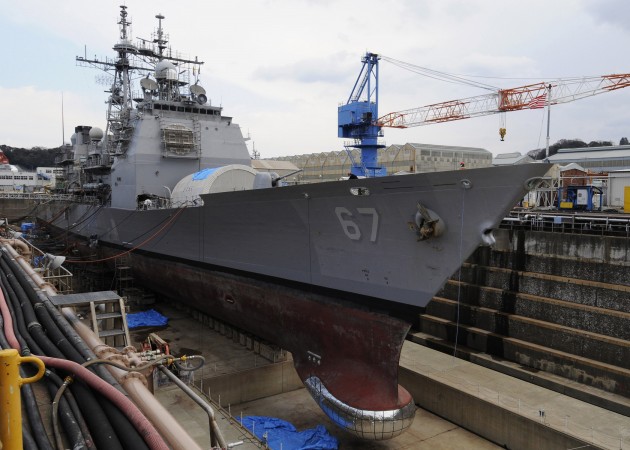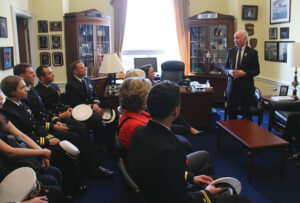
A Navy Aegis cruiser in drydock for a maintenance “availability.” Such work would be postponed or cancelled if Congress passes another Continuing Resolution.
NATIONAL HARBOR: More and more House members oppose another Continuing Resolution, which should compel the passage of proper defense spending bills, the House seapower chairman said here this morning. It’s a rare case where the deep divisions in the Republican party between defense hawks and budget hawks could actually smooth the workings of government instead of sabotaging them.

Rep. Rob Wittman
“I think leadership understands there’s not a stomach for a CR, short term or long term,” Rep. Rob Wittman told the Navy League’s Sea-Air-Space conference. “They understand there is a significant amount of resistance to a CR, and that getting 218 votes for either a short-term or long-term CR is going to be difficult; and so I would say then, being the optimist, there’s a better than 50-50 chance there’ll be some form of omnibus or cromnibus.”
“The appropriators pretty much did all the work (already). The cake has been baked,” added Rep. Joe Courtney, the seapower panel’s ranking Democrat. There’s a defense appropriations bill on the table in the Senate, the two congressmen said, which could easily be revived. “There are bipartisan discussions going on amongst the appropriators right now,” Courtney said. “We want to nurture that.”
Hitting the reset button and going back to the 2017 appropriations bill might require setting aside, at least for now, the proposed plus-ups in the Trump administration’s supplemental spending request, Wittman acknowledged. “Whatever’s reflected in the appropriations bill that at least takes us thru the end of this year,” he told reporters, “it may be you have to fluctuate some numbers there to make up for what wouldn’t be there in the supplemental.”
Let’s unpack those statements. (Hill cognoscenti can skip this paragraph). Since fiscal year 2017 began on October 1st, the government has operated on autopilot, with agencies allowed to continue spending at last year’s levels — hence the term “Continuing Resolution” — with little leeway to start new programs, cancel old ones, or make adjustments for changed circumstances, all of which require a proper appropriations bill. In ideal circumstances, Congress passes 12 such spending bills, one for defense and 11 for other agencies, but in practice some or all often get packed together in a single bill, an omnibus. A Cromnibus would be an ugly hybrid, passing proper appropriations for parts of the government — in this case, defense — while keeping the rest on a year-long CR.

Rep. Joe Courtney meets with young submarine officers.
Wittman and Courtney both expressed distaste for a Cromnibus. It’s “a very weak…Plan B,” said Courtney. “Cromnibus kind of reminds you of cronuts… It doesn’t sound right, it doesn’t taste good.”
But it’s better than a year-long Continuing Resolution. “If, God forbid, the CR does pass, thing are going to happen that are very splashy and ugly, and people are going to get a brutal awakening,” Courtney said.
Congress did allow a few narrow exceptions to the last CR, most notably an extraordinary $773 million increase to the Navy’s top-priority program, the Columbia-class nuclear missile submarine, but you can’t pass such case-by-case exceptions (called “anomalies”) for every program that might need one. “If you finish the year with a CR, you cannot cover all the shortfalls with an anomaly,” warned Wittman.
What’s worse, “the margin for error is all gone because we used that in the first CR,” Wittman told reporters after his public remarks. “They put anomalies in for Columbia-class and some other elements, but the flex we had in shipbuilding accounts has been consumed, and the same on the maintenance accounts.” Government agencies often start the year with a little fiscal wiggle room — for example, they can repurpose money appropriated for programs that have fallen behind schedule and haven’t spent it yet — but as the CR drags on month after month, that margin is used up. At this point, even a short-term CR would force the Navy to postpone important maintenance and perhaps slow down shipbuilding.
So, I asked, what are the odds of a short-term CR, a full-year CR, or a proper defense appropriations bill? “Handicapping where we are right now is — is a folly because I have no idea where the leadership is with that,” Wittman said with a laugh. “There’s nothing in the schedule unfortunately this week for things to happen, so that leaves us out of town for two weeks, and then back for maybe four days of legislating before the curtain falls on April 28th.”
In the long term, Wittman said, Congress can’t keep going home with its work unfinished like this. “I don’t believe we have to languish in CRs (forever),” he said. “It is tough work to go through regular order. I think there have to be a few motivating factors. I think that Congress shouldn’t be allowed to leave town to go home in August until all 12 appropriations bills are done.”
These words got the biggest applause of the morning, by far.
Sullivan: Defense industry ‘still underestimating’ global need for munitions
National Security Advisor Jake Sullivan said that there are “no plans” for another Ukraine supplemental at this point.


























